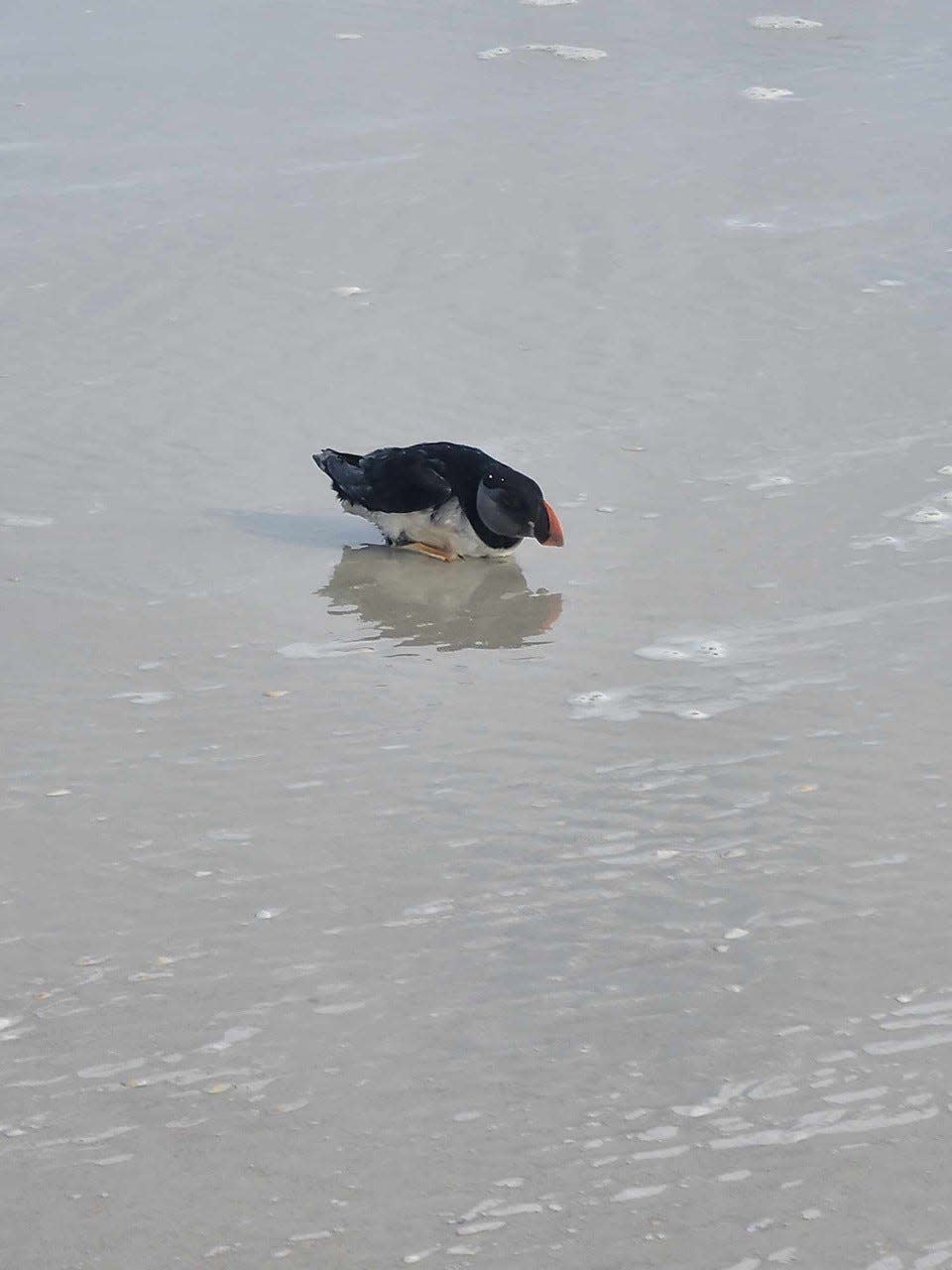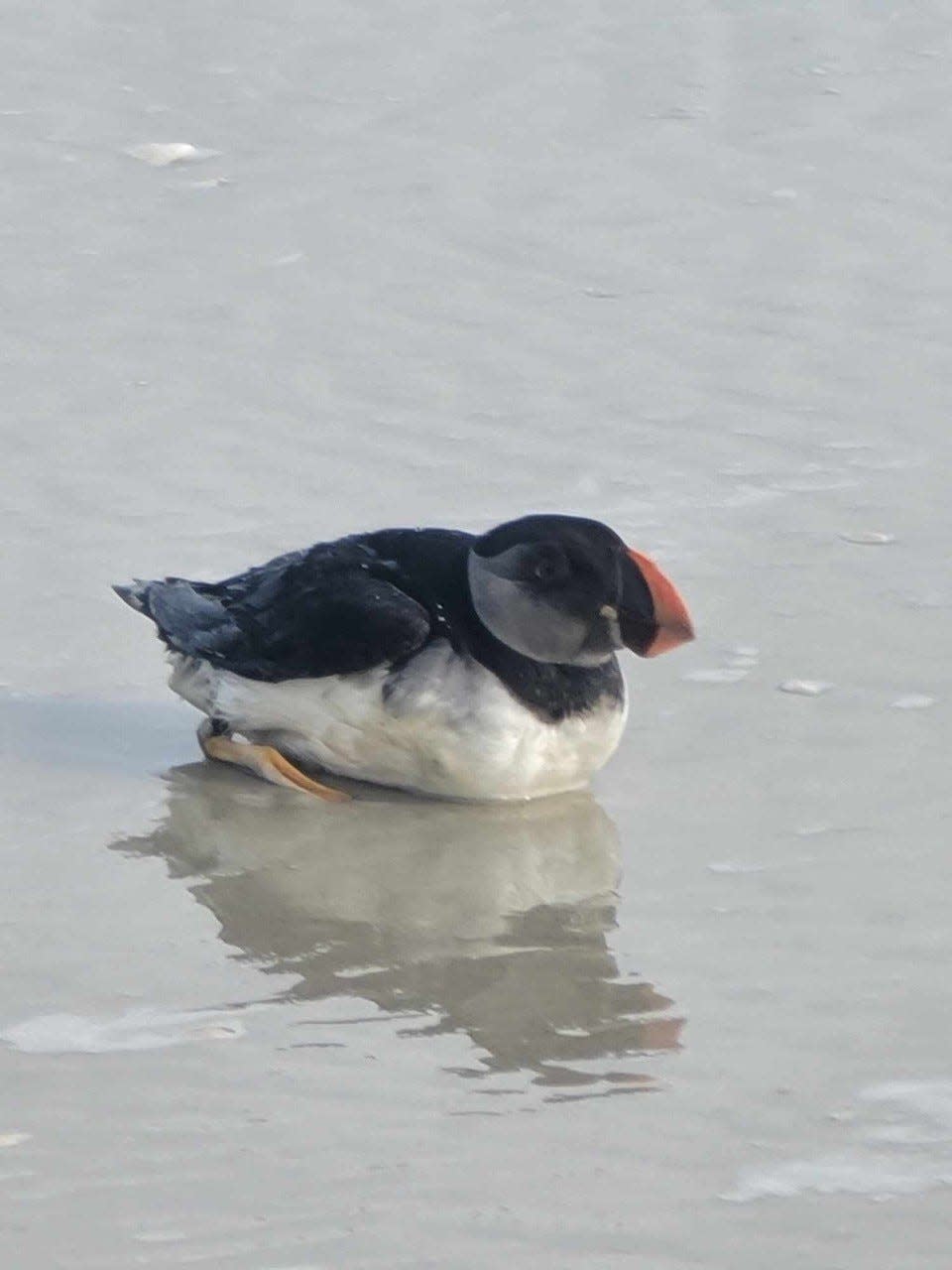Rare sight: Ponce Inlet residents find first recorded Atlantic puffin in Volusia County

In a typical day, the Marine Science Center in Ponce Inlet takes any number of injured seabirds, raptors or other bird species commonly found in Volusia County.
But last month, to employees' surprise, they treated one species they had yet to encounter: a puffin.
“We often get people who tell us they have a specific type of bird that we don’t commonly get or that isn’t from this area — we won’t dismiss it … but take it with a grain of salt,” said Kristen Mitchell, the center’s assistant bird rehabilitation manager. “So we were really surprised that it actually was what they claimed it was, a puffin. We were pretty excited to see one.”
Where do puffins live?
This is the first recording of an Atlantic puffin in Volusia County, according to the center’s manager, Chad Macfie.
“Being down in Florida isn’t a part of the puffin’s migration route,” Macfie said.
In fact, about half of the entire global puffin population nests in Iceland, according to the Smithsonian National Museum of Natural History.
The Marine Science Center was unable to save the puffin, who was found in poor health.
But how did a puffin end up in Volusia County? Who found it?
Here’s what we know.
Who found the first-ever puffin recorded in Volusia County?
Alicia De Barreno was riding her bike on the beach when she came across the puffin, which appeared to be hurt.
She called the center's bird hospital.
"You're going to think I'm crazy, but I think it's a puffin," De Barreno said.
Several people kept walking by until she waived over Karin Clemson Henigan, who was walking on the beach, and the two Ponce Inlet residents stood there trying to make sure it was in fact a puffin.
“I took some pictures and sent them around and we realized he is a puffin,” Henigan said.
Henigan said they were keeping an eye out for other animals that might want to hurt the puffin, which the two locals noticed couldn’t move.

“We thought maybe he is tired, but he was kind of flipping his legs a little bit, and he was kind of pulling himself out of the water with his beak, dragging his body,” she said.
De Barreno said she had to leave for work and told Henigan they could try to wrap the puffin in a towel and put it in a box before taking it to the Marine Science Center, since the bird hospital staff could not go to the beach at the time. The idea came to her, she said, because she had been involved in a bird rescue before.
Henigan then asked for her husband’s help and they brought the bird to the center.
“We named him Paulie — Paulie the puffin,” Henigan said. “My husband and I went back down to the center the next afternoon in hopes to visit him, and that’s when they told me he didn’t make it, so that was kind of sad.”
Mitchell said once he was brought into the center’s bird hospital, staff provided the puffin with “stabilizing care.”
Ponce Inlet updates: Beach restoration, stormwater improvements are highlights at Ponce Inlet town hall
“Mostly fluids and warmth just to stabilize the bird,” she said. “We are concerned that it was very thin and dehydrated … . Unfortunately, it did not make it.”
What is a puffin?
Puffins are marine birds distinguished by black, dark gray, or black and white plumage and a vibrantly colored beak, according to the Smithsonian.
![Two puffins [Photo by Jennifer Cooley].](https://s.yimg.com/ny/api/res/1.2/mWsf9yt8xCd9Sr4LSUvG1w--/YXBwaWQ9aGlnaGxhbmRlcjt3PTk2MDtoPTE2NTY-/https://media.zenfs.com/en/daytona-beach-news-journal/cf13310ffc8caee51d543854a4fe9ffc)
There are four different species: Atlantic puffin, horned puffin, tufted puffin and the rhinoceros auklet. They are members of the Alcidae family, more commonly known as the auks.
“With their dark cape and fat belly, the birds looked like overweight medieval friars and so they were dubbed the ‘little friars of the sea,’” according to the Smithsonian. “Puffins are also known as the ‘clown of the ocean’ and the 'sea parrot' due to their colorful facial markings.”
Their name is due to their “puff ball” appearance.
How did a puffin end up in Volusia County?
Although a puffin appearing in Volusia County was unprecedented until last month, there are signs as to how it may have ended up here.
Other puffins and auk birds have also been spotted along the Atlantic Coast, including one in Brevard County and two in Miami.
Recent periods of longshore currents produced by northerly winds have been seen off Florida's east coast, according to Robert Haley, a meteorologist with the National Weather Service office in Melbourne, Florida, told USA Today. These resulted in a large amount of upwelling between the coast and the Gulf Stream.
Puffins in Florida? Florida bird rescuers shocked by rare visitors: Puffins
“And this upwelling attracts the type of fish that puffins feed on,” Macfie said.
The fact that puffins might have been tracking their food source south combined with some recent nor’easter storms might explain why the birds have turned up in the area.
If you come across an injured bird, contact the Marine Science Center bird hospital at 386-304-5530. The center is located at 100 Lighthouse Drive in Ponce Inlet.
This article originally appeared on The Daytona Beach News-Journal: Atlantic puffin stranded at Ponce Inlet beach; first one in Volusia

